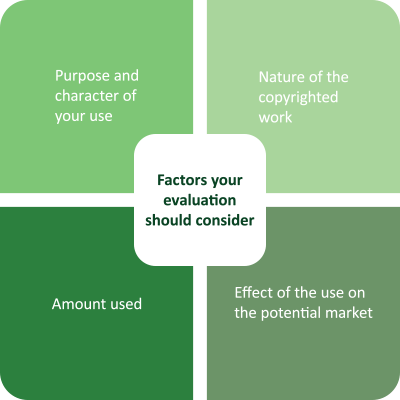Fair Use
What Is Fair Use?
You generally need to obtain permission or license copyrighted material to use it. The exception to this is a rule called Fair Use. Fair Use means you can use copyrighted material, but only for certain purposes, including “transformative” purposes. Fair use is a defense against a claim of copyright infringement.
Fair Use law tries to ensure a balance of the rights of copyright owners and the public interest, but doesn't provide simple rules to gauge whether a use qualifies as fair. Instead, you're left to evaluate your unique situation by applying the factors below.
Use the Fair Use factors below to determine if your usage is permitted. When the circumstances might be reasonably used as fair, you may use copyrighted works without obtaining permission.
These Fair Use factors help you evaluate whether your use is permitted.
Factors to Consider for Fair Use
-
 Purpose and character of your use
Purpose and character of your useThe purpose of teaching at a nonprofit educational institution is a factor favoring fair use. The scale tips further in favor of fair use when access is restricted to your students. Meeting this single condition is NOT adequate by itself.
Also at issue is the character of your use, whether you're using the works to creating something new or copying it exactly.
Have you transformed its meaning or purpose, or have you added value to and repurposed the work for a new audience? If you have, this also tips the balance in your favor.
-
Nature of the copyrighted work
Works that are published, factual, nonfiction, or newsworthy weigh in favor of fair use. If works are unpublished, fictional, highly creative, or a consumable (e.g., a workbook), then this weighs against this factor.
-
Amount used
Using a small portion of a whole work would weigh toward fairness. But sometimes it may be fair to use an entire work (such as an image) if it is needed for your instructional purpose.
-
Effect of the use on the potential market
A use is more likely to be fair if it doesn't harm the potential market for the copyrighted work or the value of the work to the copyright holder. If it does, this could weigh more heavily against fair use than any of the other factors.
Use this Fair Use Analysis Checklist to help you evaluate the work you plan to use
Research in-depth information from other external sources in Resources
Search these multiple sources to Locate Usable Works — text, images, videos, audio

